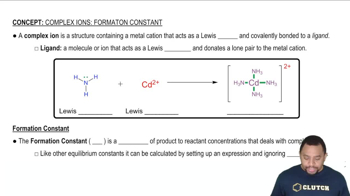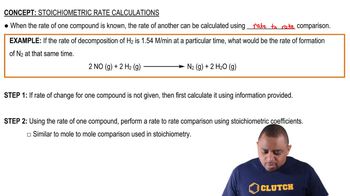Here are the essential concepts you must grasp in order to answer the question correctly.
Complex Ion Formation
Complex ions are formed when metal ions bond with ligands, which are molecules or ions that can donate electron pairs. In this case, Cr(OH)3 reacts with NaOH to form the complex ion [Cr(OH)4]-. The stability of this complex is indicated by its formation constant (Kf), which quantifies the extent to which the complex forms in solution.
Recommended video:
Complex Ions and Formation Constant
Equilibrium and Kf
The formation constant (Kf) is a measure of the stability of a complex ion in solution. A high Kf value, such as 8 x 10^29 for [Cr(OH)4]-, indicates that the complex is favored over the uncomplexed ions. Understanding how to apply Kf in equilibrium calculations is essential for determining the concentrations of species in the solution.
Recommended video:
Stoichiometry and Concentration Calculations
Stoichiometry involves the quantitative relationships between reactants and products in a chemical reaction. In this scenario, calculating the fraction of uncomplexed Cr3+ requires determining the initial concentration of Cr(OH)3 and how it changes upon dissolution and complex formation. This involves using molarity and the stoichiometric coefficients from the balanced chemical equations.
Recommended video:
Stoichiometric Rate Calculations




